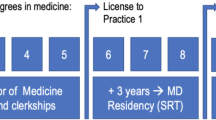Abstract
Student doctor method of clinical training or clinical clerkship provides students with exposure to the entire longitudinal illness of the patient. The students participate in patient care as a part of treating team and can refine their clinical, communication and procedural skills. It provides them with an opportunity to work with the faculty and experience the future workplace. Although the graduate medical education regulations (GMER) provide for student doctor method of training, the time provided is too little and opportunistic. Electives have also been recently added to the new curriculum for the first time. We propose a model to deliver the electives using the clerkship method, so as to consolidate what students learn from the ongoing clerkship. This model is feasible, practical and can be introduced in the current GMER for Indian medical undergraduates without any major disruptions.
Similar content being viewed by others
References
Marracino RK, Orr RD. Entitling the student doctor. J Gen Intern Med. 1998;13:266–70.
Venkatesan P, Sahoo S, Gupta R, Shrivastava S. The undergraduate medical students’ perception of student-doctor approach training for diabetic retinopathy screening. J Educ Technol Health Sci. 2019;6:25–8.
Amin Z, Burdick WP, Supe A, Singh T. Relevance of the Flexner Report to contemporary medical education in South Asia. Acad Med. 2010;85:333–9
Cotten, SR, Wilson B. Student-Faculty Interactions: Dynamics and Determinants. Higher Education. 2006; 51: 487–519.
Sarki RT, Greenberg LW, Wilking AP. Twelve tips for a successful clerkship. Med Teach. 1997;19:95–8.
US electives: Types of US clinical experience. Accessed on June 18, 2022. Available from: http://electives.us/typesofusce.html.
Walker AM. Tacit knowledge. Eur J Epidemiol. 2017;32:261–267.
Yardley S, Teunissen PW, Dornan T. Experiential learning: AMEE Guide No. 63. Med Teach. 2012;34:e102–15
Ogur B, Hirsh D, Krupat E, Bor D. The Harvard medical school-Cambridge integrated clerkship: An Innovative model of clinical education. Acad Med. 2007;82:397–404.
National Medical Commission. Regulations on Graduate Medical Education (Amendment), 2019. Accessed April 5, 2022. Available from: URL: https://www.nmc.org.in/ActivitiWebClient/open/getDocument?path=/Documents/Public/Portal/Gazette/GME-06.11.2019.pdf
Myhre DL, Woloschuk W, Jackson W, McLaughlin K. Academic performance of longitudinal integrated clerkship versus rotation-based clerkship students: A matched-cohort study. Acad Med. 2014;89:292–5.
Yale School of Medicine. MD Program: Clerkship Curriculum. Accessed July 15, 2022. Available from: https://medicine.yale.edu/md-program/curriculum/clerkships/
California University of Science and Medicine. Clinical Clerkship Handbook. (2020 2021). Accessed July 15, 2022. Available from: https://www.cusm.org/docs/Clinical%20Clerkship%20Handbook.pdf
Worley P, Silagy C, Prideaux D, Newble D, Jones A. The parallel rural community curriculum: an integrated clinical curriculum based in rural general practice. Med Educ. 2000; 34:558–65.
Teherani A, Irby DM, Loeser H. Outcomes of different clerkship models: Longitudinal integrated, hybrid, and block. Acad Med. 2013;88:35–43.
Day JA. Longitudinal Ambulatory Clerkship. The Johns Hopkins University School of Medicine. Accessed March 24, 2022. Available from: https://www.hopkinsmedicine.org/som/curriculum/genes_to_society/year-two/longitudinal-ambulatory-clerkship.html.
Stewart R, Dlhosh S, Marino C, et al. Design and implementation of a longitudinal ambulatory clerkship in the first-year curriculum at the Johns Hopkins School of Medicine. J Community Hosp Intern Med Perspect. 2011;1:7033.
Ellaway R, Graves L, Berry S, et al. Twelve tips for designing and running longitudinal integrated clerkships. Med Teach. 2013; 35:989–95.
Mahajan R, Singh T. Electives in undergraduate health professions training: Opportunities and utility. Med J Armed Forces India. 2021;77:S12–15.
Greenhill J, Poncelet AN. Transformative learning through longitudinal integrated clerkships. Med Educ. 2013;47:336–9.
Ng VK, McKay A. Challenges of multisite surgical teaching programs: A review of surgery clerkship. J Surg Educ. 2010; 67:1–8.
Vleuten CP, Van Der AJ, Scherpbier CPM, et al, Clerkship assessment assessed. Med Teach. 2000;22:592–600.
Playford D, Kirke A, Maley M, et al. Longitudinal assessment in an undergraduate longitudinal integrated clerkship: The mini clinical evaluation exercise (mCEX) profile. Med Teach. 2013; 35:e1416–21.
Mclaughlin K, Vitale G, Coderre S, et al. Clerkship evaluation—what are we measuring? Med Teach. 2009;31:e36–9.
Otago Polytechnic. Reflective writing. Accessed July 16, 2022. Available from: https://www.op.ac.nz/assets/LearningAdvice/d0a1fac268/Reflectivewriting.pdf
Milan FB, Dyche L, Fletcher J. “How am I doing?” Teaching medical students to elicit feedback during their clerkships. Med Teach. 2011;33:904–10.
Bernard AW, Kman NE, Khandelwal S. Feedback in the emergency medicine clerkship. West J Emerg Med. 2011; 12:537–42.
Hamza DM, Ross S, Oandasan I. Process and outcome evaluation of a CBME intervention guided by program theory. J Eval Clin Pract. 2020;26:1096–1104.
Hem-Stokroos HH van der, Scherpbier AJ, et al. How effective is a clerkship as a learning environment? Med Teach. 2001; 23:599–604.
Frye AW, Hemmer PA. Program evaluation models and related theories: AMEE guide no. 67. Med Teach. 2012; 34:e288–99.
Moss HA, Derman PB, Clement RC. Medical student perspective: working toward specific and actionable clinical clerkship feedback. Med Teach. 2012;34:665–7.
Funding
Funding: None
Author information
Authors and Affiliations
Contributions
Contributors: TS: Initial concept; JSK,PG,SK,PR: drafting the manuscript and review of literature; PG, SK, PR, TS: critical review of the manuscript for intellectual content. All authors approved the final version of the manuscript for publication.
Corresponding author
Ethics declarations
Competing interests: None stated.
Rights and permissions
About this article
Cite this article
Kaushik, J.S., Ramachandran, P., Kukreja, S. et al. Delivering Electives the Clerkship Way: Consolidating the Student Doctor Method of Training. Indian Pediatr 59, 710–715 (2022). https://doi.org/10.1007/s13312-022-2600-8
Published:
Issue Date:
DOI: https://doi.org/10.1007/s13312-022-2600-8




